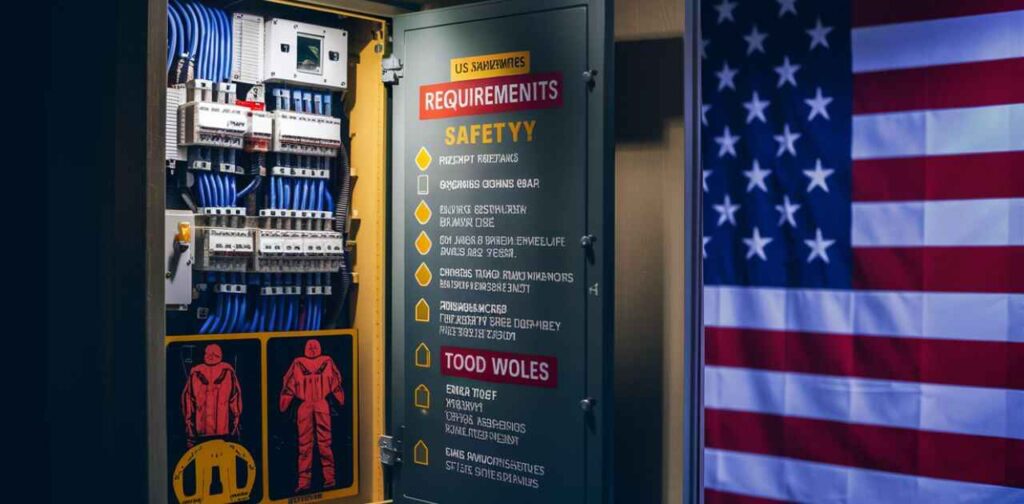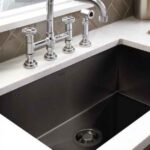Ensuring the electrical panel in your home meets proper clearance requirements is crucial for safety and code compliance. An electrical panel, also known as a breaker box or distribution board, is the vital hub that distributes electricity to all the circuits in your house. With such an essential role, it’s critical to have easy access to the panel for maintenance, repairs, and emergency shut-offs.
Violating clearance codes not only poses fire and shock hazards but can also lead to fines, legal issues when selling your home, or even void homeowner’s insurance policies. This comprehensive guide will cover the national standards and local regulations, explain why following clearance rules is worth the investment, and provide steps to bring your home up to code.
Why Proper Electrical Panel Clearance Matters
Obstructing the area around your electrical panel is an extremely serious safety hazard that should never be taken lightly. Here are some key reasons why proper clearance is absolutely vital:
- Fire Hazards: Electrical panels contain live wires, connections, and components that can generate excessive heat or arcing. If something combustible like boxes, furniture, or clutter is stored too close, it drastically increases the risk of an electrical fire igniting and spreading rapidly throughout your home.
- Shock Hazards: With inadequate clearance space, you, your family members, guests, or an electrician could accidentally come into direct contact with exposed live electrical parts inside the panel, potentially leading to dangerous shocks, burns, or fatal electrocution incidents.
- Code Violations: Most areas across the United States follow the National Electrical Code (NEC) which mandates specific minimum clearance requirements around panels. Violating these can result in hefty fines from inspectors or create legal issues when trying to sell your home down the line.
- Access for Maintenance/Emergencies: Electrical panels need to be easily and quickly accessible at all times. This allows for routine maintenance, inspections by technicians, and immediate emergency shut-offs in case of an electrical issue, malfunction, or house fire breaking out.
A shocking real-world example that highlights these risks: In 2019, a house fire in Los Angeles was severely exacerbated when the panicked homeowners couldn’t quickly access and shut off the electrical panel due to clearance obstructions from clutter and furniture. The intense flames rapidly spread out of control, resulting in over $350,000 in damages and hospitalizations.
National Electrical Code (NEC) Clearance Requirements

The National Electrical Code (NEC) is the benchmark set of regulations for electrical safety in residential and commercial buildings across the United States. It’s maintained by the National Fire Protection Association (NFPA) and updated every three years to keep up with evolving safety practices. The NEC contains explicit rules for clearances around electrical panels:
Front Clearance:
- There must be at least 36 inches (915 mm) of depth clearance in front of the panel to allow safe access and adequate working space.
- This depth is measured from the panel cover when closed towards the nearest obstruction like a wall.
Side Clearance:
- If the panel is installed in a corner, a minimum of 30 inches (760 mm) of clearance is required on each side of the panel.
- For panels not in corners, only one 30 inch side clearance is needed to access the interior.
Overhead Clearance:
- There should be no obstructions above the panel to a minimum height of 6.5 feet (2 meters) or the height of the panel, whichever measurement is greater.
- This accounts for electricians’ operating space and protects against potential arcing hazards.
It’s crucial to note that these are the absolute minimum requirements per the NEC. Many municipalities amend the code to increase clearances, especially in high-risk areas prone to earthquakes or wildfires. Always check your local regulations, as additional clearance may be mandated based on the voltage, amperage, panel type, or other regional hazards.
Working Space Requirements Around Panels
In addition to defined clearance distances, the NEC specifies criteria for dedicated working space that must be maintained around electrical panels:
Height: The designated working space in front of the panel must have a minimum height of 6.5 feet (2 meters) or the height of the panel, whichever is greater.
Width: The working space directly in front of the panel opening must be at least 30 inches (760 mm) wide. However, if the panel is larger than 30 inches wide, the working space must equal the panel width plus 30 additional inches.
Depth: As mentioned earlier, the depth of the working space is set at a minimum of 36 inches from the panel cover inwards.
Obstructions: This entire designated working space volume must be kept completely clear and free of any obstructions like equipment, storage, piping, ductwork or other installations that could impede full access to the panel.
These working space regulations ensure electricians, inspectors and homeowners have sufficient safe room to perform maintenance, inspections, repairs or handle emergency operations on the panel components when needed.
Common Violations and Obstructions to Avoid
Even if homeowners are somewhat aware of electrical panel clearance codes, it’s still extremely easy for violations and obstructions to accumulate over time. Some of the most frequent examples include:
- Large furniture items like couches, chairs, shelving units or cabinets placed directly in front of the panel
- HVAC units, water heaters or other major appliances/equipment situated too close
- General household clutter like storage boxes, holiday decorations or belongings piling up
- Permanent fixtures like workbenches installed in the working space
- Vegetation like shrubs or trees preventing full access outdoors
To visualize what not to do, refer to this diagram of egregious clearance violations:
Even temporary obstructions are unacceptable fire hazards. If you can’t permanently maintain proper clearances due to space constraints, the panel may need to be relocated by an electrician. Don’t risk disaster by assuming “it’s just for now” when it comes to electrical safety.
Bringing Panels Up to Code
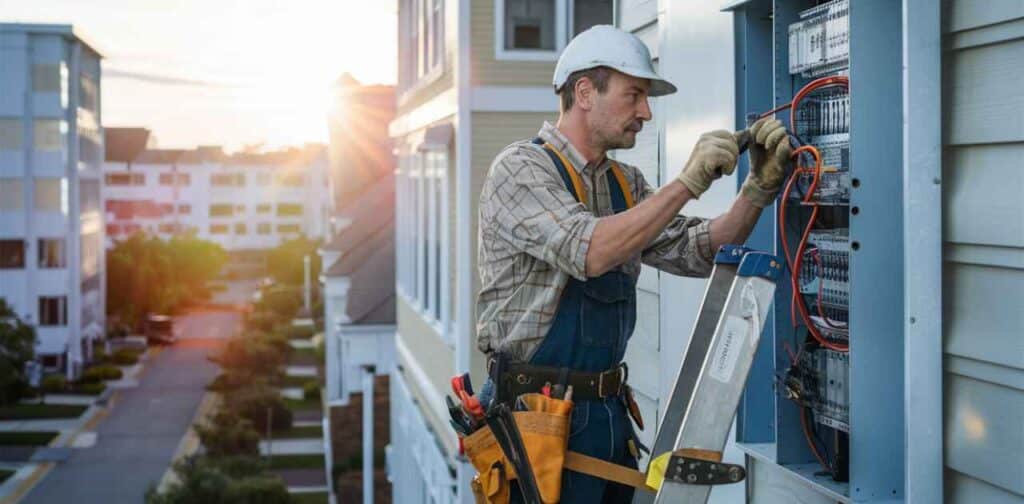
If your home’s electrical panel currently violates local or NEC clearance requirements, it’s absolutely crucial to take action promptly and properly restore safe access. Depending on the severity of the violation and your personal skill level, there are a few different resolution paths:
- Remove Obstructions: For relatively minor clearance issues like a piece of shelving or furniture in the way, you may simply need to clear out any obstructions in the working space to restore proper clearances.
- Hire an Electrician: If there are major obstructions or the panel itself is poorly located, you’ll likely need to hire a qualified, licensed professional electrician. They can assess options to relocate the panel to a code-compliant area, replace it with a properly sized and located panel, or reconfigure the entire electrical layout. Many areas legally require permits to be obtained for panel relocation, replacement or extensive electrical work. Professional electricians can handle securing these permits.
- DIY Re-Installation: For handy and experienced homeowners, it may be possible to carefully relocate a surface-mounted panel yourself after obtaining proper permits. However, this approach is absolutely not recommended for DIY inexperienced with electrical work due to the extreme safety risks of making a mistake.
Attempting major electrical work like full panel relocations without a valid license, proper permitting, and extensive experience can be extremely dangerous and is illegal in most areas. When in doubt, always err on the side of safety and hire a qualified professional electrician to ensure everything is done correctly and fully up to code. Your life is worth more than the potential cost savings.
Maintaining Panel Clearance for Safety
Once your home is brought fully up to local and NEC code clearance requirements, it’s essential to maintain those clearances going forward through good housekeeping habits:
- Never allow boxes, furniture, or any items to be stored in the working space in front of the panel
- Periodically inspect the area and immediately remove any new obstructions that appear
- Use only non-conductive ladders or step stools made of fiberglass or wood when working around panels
- Consider installing physical barriers like railings or surrounds to clearly designate the clearance area
- Educate your family, guests, contractors on respecting the clearance and keeping it unobstructed
“An electrical panel is like the heart of your home’s electrical system. You wouldn’t obstruct access to your own heart during an emergency, so why would you ever block the panel that keeps electricity safely flowing?“
Mike Holmes, Professional Contractor
By keeping electrical panels free of any obstructions whatsoever and maintaining proper clearances at all times, you’ll ensure easy access for maintenance and emergency shut-offs while eliminating potentially devastating fire and shock hazards.
Case Study: Clearance Violation Leads to $50,000+ in Damages

In 2021, a family in Seattle learned the hard way about the dangers of violating electrical panel clearances. Andrew and Sarah had just renovated their basement into a home theater room, with a loveseat and shelving unit placed directly in front of the electrical panel.
One night when watching a movie, the lights began flickering and they smelled something burning. An electrical arcing fault had occurred inside the panel due to damage from rodent nesting. With no ability to immediately access the panel and shut off power, the arcing ignited the nearby shelving.
Flames quickly spread through the basement, causing over $50,000 in property damages before firefighters could extinguish the blaze. Tragically, the family’s dog also perished from smoke inhalation after being trapped by the fire.
A post-incident investigation determined that had proper clearances been maintained, the family likely could have shut off power before the fire grew out of control. This case highlights how a simple clearance violation can have catastrophic, life-threatening consequences.
Panel Replacement and Relocation Tips
In cases where an existing electrical panel cannot realistically meet clearance codes due to space constraints or obstructions, replacement or relocation is the only solution. Here are some key tips:
Panel Replacement:
- Hire an electrician to assess if your current panel is properly sized for your home’s power needs
- Consider upgrading to a newer, safer panel with more slots/spaces if your panel is older
- Relocate the new panel to a clear, accessible area that meets all clearance regulations
Panel Relocation:
- Consult an electrician to determine the optimal new location for your panel
- Unfinished basements or garage spaces often allow for ample working clearances
- Install clear signage on the new panel location within the home
- Ensure all circuits are correctly re-connected and properly labeled at the new panel
Permits Required: In virtually all municipalities across the U.S., permits are legally required when replacing or relocating an electrical panel. These permits ensure:
- The electrician is properly licensed and insured
- The work is inspected for full code compliance
- The new panel meets requirements for your area
- All work is tracked for future home sale disclosures
Costs for these permits vary but are essential for ensuring safety. Most electricians will handle obtaining the proper permits as part of their overall service.
Related Post:
HOW TO COOL YOUR HOUSE WITHOUT ELECTRICITY
Clearance Requirements for Equipment Near Panels
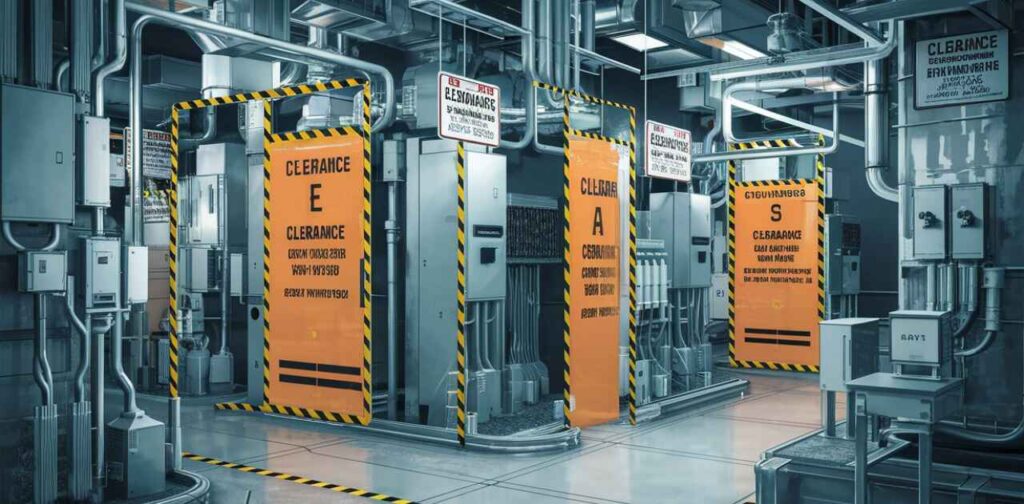
The NEC also specifies clearance rules for other equipment located in the vicinity of electrical panels to prevent potential hazards:
HVAC Units
- Maintain at least 3 feet of clearance in front of indoor HVAC units/furnaces
- This allows access for maintenance, repairs and emergency shut-offs
- Outdoor A/C condenser units need 3 feet clearance on all sides
Water Heaters
- Standard tank water heaters require a clearance of 2 feet on sides/front
- More clearance is required if the heater’s rated BTU input is very high
- Tankless/on-demand heaters need specific clearances per manufacturer
Appliances
- Refrigerators, washers, dryers and other major appliances in garages should be placed at least 3 feet from panels
- This prevents obstructed access but also reduces fire risk if the appliance malfunctions
While many homeowners are unaware, these spacing requirements around panels are also part of most building codes and home insurance policies. During inspections or insurance claims, violations could lead to fines, obligatory corrections, or even policy cancellations in some cases. It’s best to maintain proper clearances from the start.
By understanding and respecting electrical panel clearance requirements, you’ll ensure your home’s electrical system remains safe, accessible, and fully up to code. Don’t risk injuries, fines, or catastrophic damage maintain proper clearances!
Electrical Panel Clearance Checklist
To help ensure your home meets all necessary clearance codes, use this checklist when inspecting your electrical panel area:
Front Clearance:
At least 36 inches (915 mm) of depth in front of panel cover
No obstructions like furniture, boxes, or appliances in this space
Side Clearance:
- For panels in corners, 30 inches (760 mm) clearance on each side
- For other panels, at least 30 inches clear on one side
Overhead Clearance:
- Nothing obstructing the space above panel to height of 6.5 ft (2 m) or panel height
- No pipes, ductwork, shelving or other overhead objects
Working Space:
- Matches panel width plus 30 inches (760 mm) in front
- Working space depth of at least 36 inches from panel cover
- Working space height of 6.5 feet (2 m) or panel height, whichever is greater
- This entire space is completely clear of obstructions
Other Electrical Equipment:
- HVAC units at least 3 feet away from panel
- Water heaters have 2 feet front/side clearance (more for high BTU models)
- Major appliances at least 3 feet from panel, especially in garages
Access:
- Nothing blocking the path or walkway leading to panel area
- Vegetation is trimmed back for outdoor panels
- Area is well-lit for easy visibility
If you checked “No” for any of those requirements, it’s critical to take action immediately to bring your electrical panel area up to code. Even small violations increase safety risks.
Impact of Electrical Panel Clearance on Home Value
In addition to the obvious safety benefits, maintaining proper electrical panel clearance requirements can also financially protect your home’s value when it comes time to sell or refinance the property.
During the inspection process, professional home inspectors are trained to identify any glaring code violations related to electrical panels, clearances and access. Finding obstructions or lack of working space gets flagged in their report.
Prospective buyers and mortgage lenders can then use these violations as leverage to renegotiate the sale price lower or demand that the issues be corrected at the current owner’s expense prior to closing. In cases of major infractions, some buyers may even walk away entirely over electrical safety concerns.
Relocating or replacing an electrical panel that doesn’t meet code is an involved, costly project that can run between $1,500 – $4,000+ for most homes when hiring an electrician. Many sellers prefer to have this work completed beforehand to help ensure a smoother, quicker sale process.
Keeping your electrical panel up to the latest clearance codes, along with having documentation of any recent work or inspections, shows responsible maintenance and gives peace of mind to future buyers. This effort can ultimately lead to higher resale valuations and preventing bargain-basement offers from companies that buy “as-is” homes at discounts.
Even for homes not going on the market soon, inadequate electrical panel clearance could also potentially cause issues with homeowner’s insurance claim payouts down the road if a fire or other incident is deemed to be linked to that code violation.
From a financial standpoint, bringing your panel clearances up to code is a smart investment that protects both your safety and the future resale value of your property.
Exterior Panel Clearance Requirements
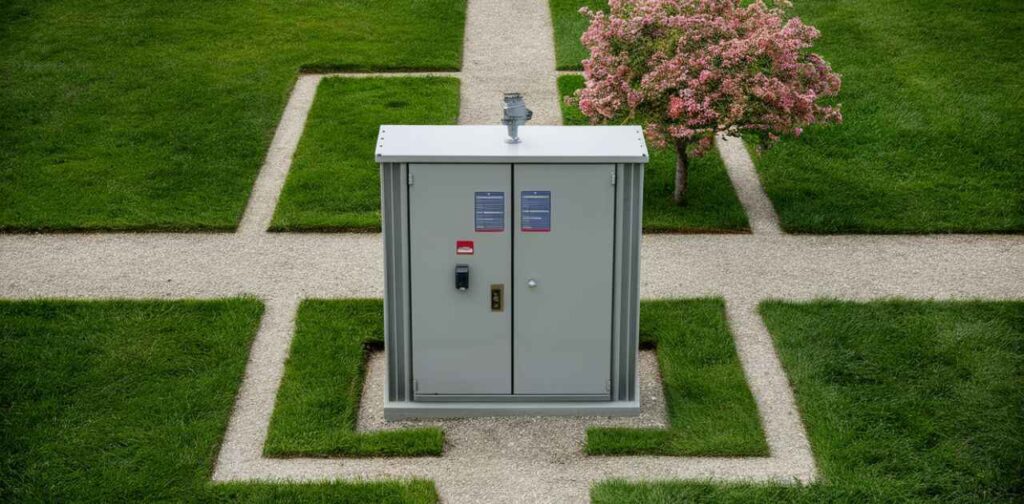
While most clearance requirements focus on indoor panels, it’s important not to overlook access and working space rules for panels installed on the exterior of homes as well.
Exterior panels must be completely unobstructed from any potential hazards like:
- Vegetation overgrowth (bushes, tree branches, ivy)
- Stored objects/trash cans beneath the panel
- Gas/Grill tanks or cylinders
- Standing water or drainage issues
- Walls or fences obstructing the front clearance
The NEC does allow for exterior panels to have slightly reduced front clearances compared to indoor:
- Indoor Panel Front Clearance: 36 inches
- Exterior Panel Front Clearance: 30 inches
However, all other required clearances for side, overhead, and working space depths are the same for both indoor and outdoor panels.
Special attention should be paid to maintaining year-round access for exterior panels. Overgrown vegetation may need regular trimming, while walkways/paths must always be cleared of ice, snow and other winter obstructions.
For detached garages, exterior panels should never be obstructed by vehicles or anything stored directly in front of the panel area.
“I’ve lost count of how many times homeowners have forgotten about or overlooked their exterior electrical panel behind overgrown bushes. Then during an emergency, we lose precious time trying to safely access the panel.“
Fire Captain Reynolds, Sacramento, CA
By keeping both interior and exterior electrical panels completely accessible at all times, you’ll ensure safety and meet all code requirements year-round.
FAQs
Can I install shelving or storage units in front of an electrical panel?
No, it is important to maintain a clear and unobstructed path in front of electrical panels. Shelving or storage units can hinder access and pose a safety risk. Ensure that there is a minimum clearance of 30 inches in front of the panel.
Are there different clearance requirements for residential and commercial buildings?
Yes, clearance requirements may vary between residential and commercial buildings. Commercial buildings often have stricter clearance requirements due to higher electrical loads and the presence of professional electricians. Always consult local building codes and regulations for specific requirements.
Can I modify electrical panel clearance requirements based on my own judgment?
No, electrical panel clearance requirements are established by regulatory bodies such as the National Electrical Code and OSHA. These requirements ensure consistent safety standards. Deviating from the specified clearance measurements can compromise safety and may lead to legal consequences.
Final Thoughts
Dedicating the proper clearance space around electrical panels is one of the most critical home safety practices, yet it often gets overlooked or deprioritized by homeowners. Maintaining these clearances can literally be the difference between a minor electrical issue and a catastrophic, life-threatening house fire.
While electrical code requirements like 36-inch front clearances may seem arbitrary or excessive, they exist based on years of research, case studies, and best practices around safe working spaces and access. Even reducing these distances by a foot or two drastically increases risks.
The good news is that following clearance regulations for your home’s electrical panel is a relatively simple, inexpensive process compared to most major safety upgrades. In many cases, it’s just a matter of keeping the area in front of the panel clear of any stored items or obstructions.

Howdy is behind this home blog, sharing personal stories, thoughts, and insights from daily life. I can dedicated to bringing you the latest trends, expert advice, and creative ideas to make your home the sanctuary you’ve always dreamed of. Whether you’re looking for DIY tips, home decor inspiration, home loans, rentals or renovations.

